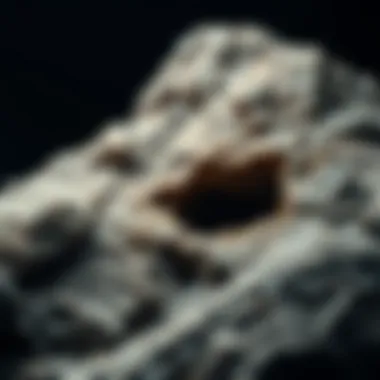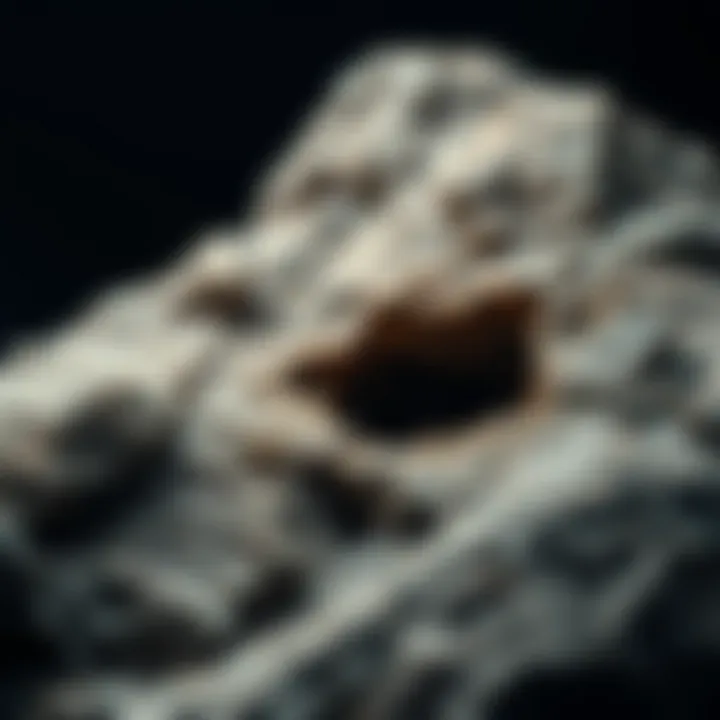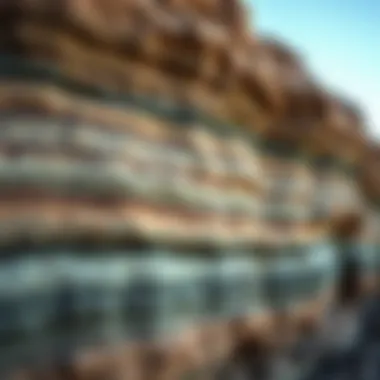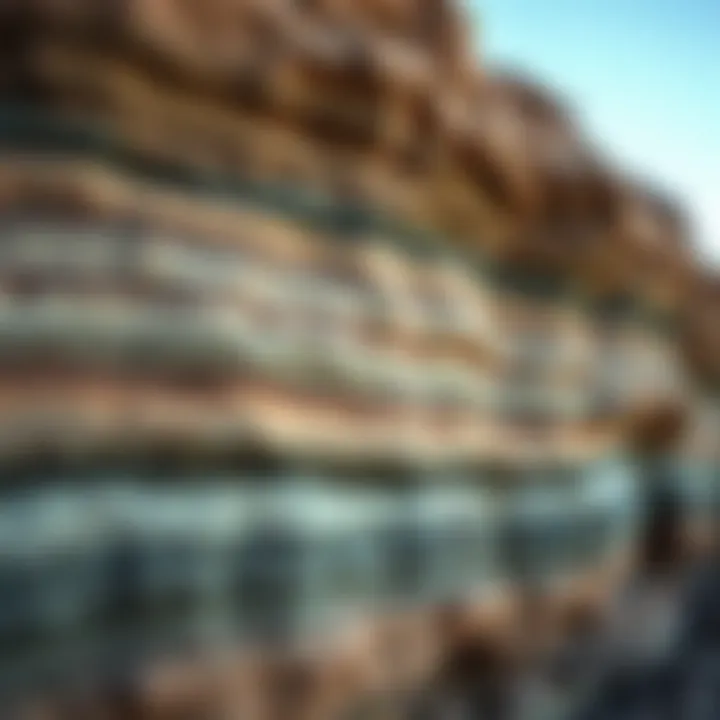Identifying Rock Types: A Comprehensive Guide


Intro
Rocks, the very fabric of our Earth, have stories to tell. They are not merely hard entities scattered beneath our feet; they serve as historical records, forged by the fiery breath of volcanoes, the slow embrace of rivers, and the immense pressures deep within the crust. For enthusiasts and collectors, understanding rock types can be akin to unlocking a treasure trove of knowledge about the planet's past.
In this guide, we will delve into the intricacies of rock identification and classification. We will break down the three primary classes of rocks: igneous, sedimentary, and metamorphic. Each class, diverse and fascinating in its own right, offers unique insights into Earth's geological wonders.
Stay tuned as we explore identification techniques that can enhance not only your collecting experience but also deepen your appreciation for these timeless specimens. Now, let’s take a look at the origins and history of rocks and fossils, establishing a critical understanding of their allure and significance.
History and Origins
Overview of Collectibles, Rocks, and Fossils
Throughout history, rocks and fossils have held significant value across cultures. Ancient civilizations crafted tools, structures, and art from these natural materials, recognizing their durability and aesthetic appeal. Mother Nature's handiwork, rocks are more than just collectibles; they embody the Earth’s evolutionary tale. Fossils, in particular, are like snapshots into prehistoric life, with each specimen representing a unique moment in time.
The Connection to Collectors
For modern-day collectors, the thrill lies in discovering unique specimens. Some collect rocks for their beauty, while others pursue fossils to piece together the puzzle of biological history. Enthusiasts often attend rock shows, join clubs, or take part in field trips, which provides a platform to share knowledge and foster community among like-minded individuals.
Historical Significance and Cultural Impact
The historical journey of rock collecting dates back to antiquity. Many societies revered specific stones, attributing them with spiritual meanings or practical purposes. For example, jade was highly prized in ancient Chinese culture for its beauty and symbolism, while lapis lazuli was cherished by the Egyptians as a luxury item.
In more recent history, the 19th-century gold rushes and mineral booms ignited interest in geology, leading to a surge of public fascination with rocks and minerals. Collecting became a popular hobby, and scientific inquiry into geology expanded significantly during this time. Museums began showcasing extensive collections, and institutions emerged to study rocks and their properties rigorously.
“The study of geology is a window into the past, allowing us to understand the forces that shaped our world today.”
Moving forward, we must turn our attention to the processes involved in rock identification and classification in the next section. This will equip enthusiasts with the tools necessary to discern the subtle differences and varied characteristics of these fascinating materials.
Identification and Classification
Guide to Identifying Rocks and Fossils
Identifying rocks and fossils involves more than just visual inspection. Attention to details like hardness, luster, color, and texture can reveal much about each specimen’s identity. Here are some key attributes to consider:
- Color: While it can be deceiving, color offers immediate clues. For instance, the striking red hue of a sandstone is indicative of its iron content.
- Texture: The feel of rocks varies widely. Igneous rocks can have a coarse or glassy texture, while sedimentary rocks often feel grainy or layered.
- Hardness: This can be measured using Mohs hardness scale. Knowing how your specimen measures up against common minerals can help you identify it.
- Fossil Features: When examining fossils, look for features such as the shape, size, and any impressions that may indicate the type of organism.
Common Types and Variations
As you inch closer to mastering rock identification, let’s outline commonly encountered types:
- Igneous Rocks: Formed from cooled magma and classified into two categories—intrusive (like granite) and extrusive (such as basalt).
- Sedimentary Rocks: Created through sediment deposition. Common examples include limestone, shale, and sandstone.
- Metamorphic Rocks: Result from the transformation of existing rock under heat and pressure. Examples include schist, gneiss, and marble.
This understanding not only enriches your collection but also cultivates a deeper connection to the world beneath our feet. As we continue with this guide, we will further explore techniques that can amplify your field observations and enrich your collecting experience.
Prelude to Rock Classification
Rock classification plays a pivotal role in understanding the Earth's geology and the vast array of materials that make up our planet. By categorizing rocks based on their characteristics and formation processes, enthusiasts gain insights into the history of the Earth, its processes, and the changes it has undergone over millennia. Understanding rock types is not just an academic pursuit; it can offer practical benefits to collectors and hobbyists alike, enhancing their appreciation and knowledge of this natural world.
Through rock identification, one can discover clues about the environment in which a rock formed, which may significantly contribute to local history or the natural resources available in a region. Furthermore, as one delves deeper into this subject, they uncover a shared passion with others in the community—be it fellow collectors, geologists, or simply nature lovers.
The Importance of Rock Identification
Identifying rocks is more than just a fun activity; it forms the backbone of geological studies and environmental understanding. By recognizing the type of rock, you can ascertain its age, origin, and even its role in various natural processes. This knowledge is essential for anyone interested in geology, environmental science, or even archaeology. For collectors, the ability to identify and classify rocks leads to greater insight into one's collection. It grants value to the pieces you possess and allows for intelligent conversations about their attributes.
Overview of Rock Types
Rocks can be broadly classified into three main types: igneous, sedimentary, and metamorphic. Each of these categories has distinct characteristics and formation processes, making them unique from one another.
Definition of Igneous Rocks
Igneous rocks arise from the cooling and solidification of molten material called magma or lava. Their identification is typically based on texture and mineral composition. For instance, granite, a common type of igneous rock, displays a coarse texture and contains primarily quartz, feldspar, and mica. On the flip side, basalt, which cools rapidly, often displays a fine-grained texture and is rich in iron and magnesium. Their formation process makes igneous rocks popular among collectors for their diverse colors and textures. However, recognizing them can be tricky without good observation skills, given the variations in crystal sizes and mineral content.
Definition of Sedimentary Rocks
Sedimentary rocks are formed from pre-existing rocks or organic materials through processes like compaction and cementation. This forms layers of sediment, often leading to unique features such as fossils or distinct striations. Sandstone and limestone are common examples. Sandstone, made of quartz grains, is typically porous, allowing it to hold water. On the other hand, limestone often contains fossils, making it intriguing for collectors interested in ancient life. Collecting sedimentary rocks can be rewarding as they often tell stories of ancient environments, but their layered nature can sometimes confuse newcomers trying to identify them.
Definition of Metamorphic Rocks
Metamorphic rocks emerge from the transformation of existing rock types due to heat, pressure, or chemically active fluids. This process alters the mineral composition and texture of the original rock. Take slate, for instance—derived from shale; it has a fine-grained texture and can easily break into thin layers, making it highly desired for roofing tiles. Marble, stemming from limestone, is prized for its beauty and used in sculptures and architecture. Understanding metamorphic rocks can be especially rewarding for collectors, as they often showcase stunning colors and patterns, although they can pose challenges when distinguishing them from their parent rocks.
In summary, grasping the definitions and characteristics of these three rock types helps set the stage for deeper exploration into rock classification. Being well-versed in these fundamentals is not only beneficial but essential for anyone looking to appreciate the complexities of geological materials.
Physical Properties of Rocks
Understanding the physical properties of rocks is essential in the art of rock identification. These properties can reveal a lot about the rock's formation, age, and the environment it originated from. For rock and fossil collectors, grasping these characteristics allows for informed decisions regarding classification and appreciation. Physical attributes such as color, texture, hardness, and specific features like cleavage and density play a pivotal role in distinguishing one rock type from another. Knowing these elements not only enhances collection quality but also enriches the entire experience of interacting with the geological world.
Color and Texture
Color is often the first feature to catch a collector's eye, serving as a basic identifier among various rock types. It can be influenced by the minerals present within the rock, the level of weathering it has encountered, or even the particular environment where it formed. For instance, granite displays a speckled texture due to its varied mineral content, making it easily distinguishable.
Texture complements color, providing further insight into a rock’s history. A rough texture might suggest a more turbulent formation process, often linked to igneous rocks, while smooth textures could indicate sedimentary origins shaped by water erosion. Collectors should take careful note of how these elements interplay, as they can significantly influence identification.


Hardness and Luster
Hardness refers to a rock's resistance to scratching. The Mohs scale is a common reference for gauging hardness, ranking minerals from talc, the softest, to diamond, the hardest. Recognizing hardness can assist in determining rock type; for example, quartz is relatively hard compared to calcite, which is softer and can be scratched with a fingernail. Hardness helps collectors avoid confusion between similarly appearing specimens.
Luster describes how light interacts with a rock's surface. Rocks exhibit different types of luster, ranging from shiny (metallic) to dull (earthy). For example, galena has a metallic luster, while chalk has an earthy one. Distinguishing between these qualities helps collectors accurately categorize rocks and appreciate the complexities of their appearances.
Other Key Physical Features
Fracture Patterns
Fracture patterns refer to how a rock breaks when it is subjected to stress. Unlike cleavage, which refers to smooth breaks along defined planes, fractures can create jagged edges and uneven surfaces, revealing a rock’s internal structure. Understanding fracture patterns contributes to identifying mineral composition and structural integrity; for example, the conchoidal fracture seen in obsidian is a key characteristic that signals the rock's volcanic origins. This unique feature aids in distinguishing obsidian from other black rocks, making its recognition straightforward.
Cleavage
Cleavage is an important property concerning the way certain minerals and rocks break. It defines the tendency of a rock to split along defined planes, resulting in smooth surfaces. This property is particularly prevalent in minerals like mica, which cleaves into thin sheets. Collectors need to observe cleavage carefully, as it often provides definitive clues to mineral composition. The disadvantage with some rocks is that they may exhibit imperfect cleavage, leading to confusion during identification. Nonetheless, recognizing cleavage allows a deeper understanding of the geological processes that shaped the rock.
Density
Density, which is the mass of a rock relative to its volume, plays a significant role in the classification process. Different rock types, due to their composition, have distinct densities; for instance, basalt is denser than pumice, which is why pumice can float on water. Recognizing density can aid collectors in estimating the composition of a sample even before a deeper analysis. However, density can sometimes mislead if not weighed against other properties, as rocks with similar densities can belong to different types. Keeping density in consideration alongside other physical traits offers more clarity in identification.
Understanding these physical properties paves the way for collectors to challenge themselves and refine their rock identification skills. Knowledge empowers enthusiasts, allowing for active participation in conversations about geological specimens.
Geological Processes and Rock Formation
Understanding geological processes is crucial for identifying and appreciating different rock types. It explains how rocks form, evolve, and interconnect through natural processes that take millions of years. Each stage in the formation lays the groundwork for the next, making it essential to grasp these dynamics.
When we look at how rocks come to be, we see the impact of volcanic eruptions, erosion, sedimentation, and intense heat and pressure. These processes don't merely create rocks but also define their properties and characteristics, making identification possible. Knowing the conditions under which a rock was formed can point to its classification as igneous, sedimentary, or metamorphic. This provides valuable context to collectors, allowing them to appreciate the formation history behind the specimens they own.
Moreover, recognizing the connections between these processes aids in predicting where certain rocks may be found in nature. For example, areas with past volcanic activity often yield igneous rocks while riverbanks are prime spots for sedimentary deposits. This knowledge empowers enthusiasts to search more effectively during their explorations.
Understanding rock formation processes connects enthusiasts with the history of our planet and enriches their rock-collecting journey.
Igneous Rock Formation
Igneous rocks form from the cooling and solidification of molten material known as magma or lava. This transformation can occur beneath the earth's surface or above, giving way to two distinct categories: intrusive and extrusive processes. Each pathway provides insights into the nature of the rocks formed.
Intrusive vs. Extrusive
Intrusive igneous rocks, like granite, develop when magma cools slowly underneath the Earth’s crust. This gradual cooling allows large crystals to form, giving these rocks a coarse texture. On the other hand, extrusive rocks, exemplified by basalt, form quickly when lava erupts and comes into contact with air or water. This swift cooling results in much finer-grained textures.
Both types present unique characteristics—intrusive rocks showcase durability and are often utilized in construction, whereas extrusive rocks can vary greatly in appearance depending on cooling rates and mineral content. Collectors benefit from knowing these distinctions as they provide a clearer roadmap for identifying specific igneous rocks based on their textural attributes and origins.
Common Igneous Rock Types
Among the igneous rock family, certain types are more common and widely studied, making them important for collectors. Granite, a quintessential intrusive rock, is known for its strength and often granular appearance. It's also a go-to choice in architecture for countertops and flooring due to its aesthetic appeal and durability.
Conversely, basalt is the most common extrusive rock found on Earth's surface, often characterized by its dark color and fine-grained structure. Its widespread presence in oceanic crust makes it a fundamental rock type for geological studies, providing significant insights into Earth’s volcanic history. Both granite and basalt serve as prime examples for enthusiasts looking to expand their collections while understanding fundamental rock classification.
Sedimentary Rock Formation
Sedimentary rocks arise from the accumulation of mineral and organic particles. Over time, these materials compact and cement together under the weight of overlying sediments. This formation process occurs in various environments, from riverbeds to ocean floors, presenting a rich field for exploring different rock types.
Clastic, Chemical, and Organic Rocks
Sedimentary rocks can be categorized into clastic, chemical, and organic. Clastic rocks are formed from mechanical weathering debris, such as sandstone, which is composed of sand-sized particles compacted over time. Chemical rocks, on the other hand, result from the precipitation of minerals from solution, exemplified by limestone that forms in marine environments as a result of calcium carbonate deposits. Organic rocks, like coal, emerge from the accumulation of plant material in swampy areas.
Each of these types offers distinctive characteristics and stories. For instance, clastic rocks often indicate past environments where physical processes dominated, while chemical and organic rocks can reveal biological conditions and ancient life forms within the same era. Thus, recognizing these formations enriches the collector's understanding of sedimentary rocks far beyond surface appearances.
Metamorphic Rock Formation
Metamorphic rocks are born from the alteration of existing rocks, be they igneous, sedimentary, or other metamorphic types, due to changes in temperature, pressure, or the presence of chemically active fluids. This transformative process yields remarkable results, leading to diverse textures and mineral compositions.
Regional vs. Contact Metamorphism
When discussing metamorphic formation, it's essential to distinguish between regional and contact metamorphism. Regional metamorphism occurs over large areas under high pressure and temperature, often associated with tectonic forces, giving rise to slate from shale and schist from fine-grained rocks. In contrast, contact metamorphism affects rocks in close proximity to molten magma or lava, leading to changes in mineral structure and composition, as seen in the transformation of limestone into marble.
Both metamorphic processes highlight the dynamic nature of Earth’s geology. Understanding these distinctions aids rock collectors in identifying the origins of their specimens and appreciating the complex pathways that lead to their formation. Thus, the detailed investigation of metamorphic rocks serves as a window into the geological past, underscoring the intricate balance between elements that forge the world beneath our feet.
The Rock Cycle
The rock cycle is an essential concept in geology that illustrates the continuous transformations that rocks undergo over time. This process is vital for anyone looking to identify various rock types as it provides insight into how rocks are formed, altered, and recycled. Understanding the rock cycle not only enhances identification skills but also offers a broader perspective on how geological processes shape the earth’s crust and influence mineral resources.
In essence, the rock cycle connects igneous, sedimentary, and metamorphic rocks. Each type of rock plays its own unique role in this cycle, and understanding these roles helps rock and fossil collectors make informed observations about their finds.
Understanding the Rock Cycle Process
At its core, the rock cycle comprises several processes that dictate the life cycle of rocks:
- Formation: Rocks originate through various processes. Igneous rocks form from cooling magma or lava, sedimentary rocks result from the accumulation of minerals or organic matter, and metamorphic rocks develop from existing rocks under heat and pressure.
- Weathering and Erosion: Weathering breaks down rocks into smaller particles. These fragments can be transported by wind, water, or ice to new locations, where they may accumulate and eventually compact into sedimentary rocks.
- Heat and Pressure: Existing rocks can transform due to significant heat and pressure, creating metamorphic rocks. This process exemplifies the dynamic nature of rock experiences.
- Recycling: Ultimately, all rock types may eventually be recycled into new forms through melting, weathering, and geological forces.


Understanding this cycle is crucial for rock collectors, as knowing the origins of a rock influences how they approach identification. By recognizing whether a rock originated from volcanic activity or has been shaped by sedimentation, collectors can make educated guesses about its classification.
Interrelationship Between Rock Types
The interrelationship among the three main rock types—igneous, sedimentary, and metamorphic—is a remarkable feature of the rock cycle. Each rock type shares connections with the others, which can be summarized as follows:
- Igneous to Sedimentary: When igneous rocks weather, they break down into smaller particles that can become sediment. Over time, these sediments can harden to form sedimentary rocks.
- Sedimentary to Metamorphic: Sedimentary rocks can be buried under layers of other rocks, subjected to heat and pressure, transforming them into metamorphic rocks.
- Metamorphic to Igneous: If metamorphic rocks are subjected to extreme heat, they may melt back into magma or lava, thus beginning the cycle anew as igneous rocks.
This interrelationship highlights the fluidity of rock types and emphasizes that no rock is static. For rock enthusiasts, this understanding unveils the journey of a rock from formation to its current state and makes the process of identification more meaningful.
Understanding the rock cycle equips rock and fossil collectors with a deeper appreciation for the geological history captured in each specimen.
In summary, the rock cycle is not just a theoretical framework; it's the lifeblood of geology and a critical tool for those engaged in rock collection. Grasping this concept simplifies the complex connections and transformations that define each rock type, enriching the experience of both novice and expert collectors alike.
Tools for Rock Identification
Rock identification might seem like using a bit of magic sometimes, but it boils down to having the right tools in your kit. The world of geology is vast and layered, and having the proper instruments can make or break your understanding of the rocks you encounter. This section lays out those essential tools that will not just simplify the identification process but also enhance your rock-collecting experience. We’ll dive into specific items that stand out for their utility, effectiveness, and any quirks they may have.
Essential Identification Tools
When it comes to identifying rocks, a few tools might just be your best buddies on this journey. Each tool serves a unique purpose and brings something different to the table, allowing you to peel back the layers of your specimens with a greater degree of precision.
Magnifying Glass
A magnifying glass is a staple in any amateur or professional geologist's toolkit. This tool enhances your ability to see minute details on the rock surfaces, such as grain structure, mineral distributions, or even potential flaws that might not be visible to the naked eye. The key characteristic of a magnifying glass is its ability to provide clarity without the need for complex equipment, making it a widely appreciated choice for rock enthusiasts.
One unique feature of magnifying glasses is their portability; they can easily fit in a pocket or a small pouch—perfect for fieldwork. However, it’s worth mentioning that the effectiveness of a magnifying glass can vary based on quality. A poorly made glass can sometimes create distortions, which could ultimately mislead your examination. On the flip side, a high-quality lens offers clarity and detail, making it an indispensable tool for rock identification.
Scratch Test Kit
The scratch test kit can feel a bit rudimentary at first glance, but it opens up a door to understanding hardness, one of the elemental properties of minerals. This kit typically includes a collection of different hardness reference points to compare with the rock you’re examining. The fundamental characteristic of this kit is its ability to help you determine where your rock stands on the Mohs scale of hardness. For collectors, knowing the hardness level is crucial, as it aids in the identification of various minerals.
A unique aspect of the scratch test kit is its hands-on approach; you’re not just visually identifying—it’s tactile. Of course, the main disadvantage is that it may damage softer specimens, so using it cautiously is advisable. Still, when used judiciously, it’s a beneficial component of any rock identification process.
Acid Test Kit
The acid test kit is particularly interesting for the identification of carbonate minerals, such as limestone and marble. When you apply a few drops of acid to these rocks, a telltale fizzing reaction occurs, signaling the presence of calcium carbonate. This kit's significant characteristic is its decisiveness—if containing carbonate, the fizz is a clear indicator.
The unique feature here is the simplicity of the test; just a drop or two can yield quick results. However, caution is warranted. Acids can be hazardous, and using them demands a level of responsibility, along with proper safety gear. Despite the risks, the acid test kit comes highly recommended due to its effectiveness in providing definitive identification results.
Field Guides and Resources
Now that we've covered the key tools, let’s not forget about the value of field guides and resources. These books and websites are treasure troves of information that can help direct your exploration and improve your rock-identifying prowess. They often contain detailed descriptions, imagery, and tips that resonate with both novice and experienced collectors alike. Utilizing such resources can significantly elevate your knowledge and make the journey through the rocks even more rewarding.
Practical Steps for Identification
When it comes to identifying rocks, there’s a method to the madness. Practical steps form an essential part of this whole identification game. They offer collectors a structured approach to not only figure out what they have in hand but also to deepen their understanding of geological processes. This section dives into specific techniques that can empower you in your rock-hunting journey. Knowing how to conduct a thorough visual examination, perform physical tests, and analyze geological contexts adds layers to your skills and becomes indispensable for any serious collector.
Conducting a Visual Examination
Visual observation is often the first step in rock identification. What you see can tell you a lot about the type of rock you’re dealing with. Start by looking closely at color and texture. Is the rock grainy, smooth, or something in between? Pay attention to its overall appearance.
- Color and Patterns: Colors can vary widely. Some rocks might be speckled, while others show more uniform hues. These color patterns can hint at how the rock formed.
- Grain Size: Larger grains typically indicate slow cooling, often associated with igneous rocks like granite. Smaller grains might hint at quicker cooling, common in basalt.
Artifacts or inclusions can also be noticeable. If you see little bits of other materials embedded within the rock, they can provide crucial context for identifying sedimentary types. Overall, taking time to inspect the rock visually and noting its details creates a strong foundation for identification.
Performing Physical Tests
Once you’ve completed your visual inspection, it’s time to roll up your sleeves and get into some physical testing. These tests offer concrete data about the rock's properties, helping you narrow down the possibilities.
Hardness Test
The hardness test stands out as a fundamental technique in rock identification. It’s based on the Mohs scale of hardness, which ranks minerals from one to ten. What makes this test special is its simplicity. By scratching the rock against common items like a fingernail, a copper penny, or a glass plate, you can determine its hardness level:
- A rock that scratches glass likely rates around a 5 or more on the Mohs scale.
- One that can only be scratched by a copper penny might fall between 3.5 and 4.
This test is beneficial because it requires minimal equipment, and it gives immediate results that help to distinguish between common rock types. However, be cautious—certain rocks can be damaged, and this method works best when the rock’s surface is clean and free of any coatings.
Fizzy Reaction with Acid
The fizzy reaction with acid is another classic method, particularly effective for identifying carbonate minerals. Simple vinegar can do the trick; when applied to rocks like limestone or marble, you can see fizzing as the acid reacts with calcium carbonate. What does this mean? It signals the presence of carbonates—clear evidence that you're likely dealing with a sedimentary or metamorphic rock.
- Characteristics: This test is straightforward and highly visual, giving you immediate feedback about the rock's composition.
- Considerations: While it’s a popular test, keep in mind that not every rock will react, and some might need stronger acids to show any reactions at all. Safety is also a concern—use caution when handling acids to avoid mishaps.
Analyzing Geological Context
The final step involves considering the geological context in which you found your rock. This step situates your specimen in its broader landscape, helping you understand its origins. Ask yourself:
- Where was the rock collected? The locality can provide hints regarding the rock type. Seashores, riverbeds, or mountain ranges offer different types of stones.
- What other geological features nearby? The presence of volcanoes, rivers, or sedimentary basins can offer crucial clues.


By piecing together these clues, you’re working to make educated deductions about your specimen. The geological context is often the missing puzzle piece that ties everything together.
Understanding these practical steps strengthens your rock identification process. Engaging in visual examinations, performing physical tests, and analyzing geological context create a well-rounded approach. Each step complements the others, leading to a more accurate and satisfying identification journey.
Common Rock Types and Their Identification
Identifying rock types is not just an exercise in classification. It’s a vital skill for geologists, hobbyists, and collectors alike. Each rock type carries its own history and can tell a unique story about the Earth's processes. Knowing how to distinguish among common rock types allows collectors to appreciate the nuances of each specimen, enabling deeper connections with the natural world.
Understanding the characteristics of various rocks helps you establish an informed choice when collecting. Certain features, such as texture, color, and mineral content, provide essential clues for identification. This section delves into the identification of igneous, sedimentary, and metamorphic rocks, highlighting their distinctive attributes and where to commonly find them.
Identifying Igneous Rocks
Igneous rocks form from the solidification of molten material, and they are categorized into two main classes: intrusive and extrusive. Each class has unique identifiers, making them essential for collectors to recognize.
Granite
Granite is a prominent type of intrusive igneous rock that holds a significant place in the world of geological study. Its hallmark is a coarse-grained texture, composed mostly of quartz, feldspar, and mica. This unique feature not only provides aesthetic appeal but also contributes to its popularity in construction and decorative purposes.
As a robust building material, granite is highly durable and resistant to weathering. Its ability to resist scratches makes it ideal for countertops and monuments. However, the trade-off is its weight and difficulty in quarrying, which are considerations for collectors. Marble, on the other hand, often garners more attention due to its polishable qualities, but granite remains a staple for those seeking longevity and strength in their specimens.
Basin or Basalt
Now, let’s turn our gaze to basalt, particularly found in volcanic regions. Basalt is an extrusive igneous rock that forms from the rapid cooling of lava. Its key characteristic is a fine-grained texture, primarily composed of pyroxene and plagioclase. The dark color of basalt can be striking, offering a dramatic palette for collectors.
One distinctive feature of basalt is its formation in large, flat plains or mountainous regions, where past volcanic activity shaped the landscape. While basalt can be easier to obtain than more precious rocks, its uniformity may not appeal to all collectors. Despite this, it's a practical choice for those interested in understanding volcanic processes and the Earth's crust.
Identifying Sedimentary Rocks
Sedimentary rocks are formed through the accumulation of sediment, and they often reveal valuable information about the environment in which they were created. The following sections discuss some notable types:
Sandstone
Sandstone is composed mainly of sand-sized particles, which makes it a prevalent and recognizable sedimentary rock. The key characteristic of sandstone is its varied coloration, ranging from rusty reds to golden yellows, depending on the minerals present.
As a common building material for structures, sandstone is both aesthetically pleasing and functional. However, it can be susceptible to weathering and erosion, requiring careful handling by collectors. Interestingly, sandstone can preserve fossils and other ancient materials within its layers, making it a treasure chest for those interested in paleontology.
Limestone
Limestone is another widely known sedimentary rock. It's primarily made up of calcite and often formed from the remains of marine organisms. Its key feature is the ability to react with hydrochloric acid, producing a distinctive fizz, which serves as a practical identification test.
Limestone has various applications, from building stone to its use in cement production. Collectors enjoy limestone for its diverse sedimentary features, including fossils, but they must consider that its solubility can lead to fading over time in poorly managed displays.
Shale
Shale consists of compacted clay and silt particles, which gives it a fine-grained texture. A significant characteristic of shale is its ability to split into thin layers. This property not only allows collectors to examine individual laminations but also showcases the rock's history and formation under pressure.
Shale is a great option for those looking to understand depositional environments, yet it can be prone to fracture if handled without care. It provides a canvas of geological time, and many collectors cherish it for its storytelling potential.
Identifying Metamorphic Rocks
Metamorphic rocks arise from the transformation of existing rock types under heat and pressure, and they often exhibit striking visual transformations. Let's investigate two notable types:
Slate
Slate is a metamorphic rock that forms from shale under intense pressure and used widely for roofing and flooring. Its primary characteristic is the ability to be split into smooth sheets. Slate possesses a fine, grainy texture, and the variety in color—from dark gray to purple—makes it visually appealing.
Its utility in construction environment is matched by its aesthetic. However, slate's soft nature makes it prone to scratches and chips, demanding proper care and maintenance from collectors. Nonetheless, it illustrates the processes of metamorphism beautifully.
Marble
Marble shines brightly as a high-value metamorphic rock. It originates from limestone, undergoing a metamorphic process that results in its characteristic patterns and vivid color variations. The notable translucence of marble adds to its allure, making it popular in sculptures and architecture.
While marble is synonymous with elegance and artistry, it is softer than granite and limestone, making it more susceptible to damage. Collectors who sit back in admiration of its beauty must also handle it with care.
In summary, recognizing these common rock types helps enthusiasts deepen their appreciation for the geological world. Understanding their characteristics not only enhances the collecting experience but also provides insights into Earth's history.
Finale
The journey through the realm of rocks leads us to understand their essence far beyond mere aesthetics. In this concluding section, we reflect on the significance of rock identification and the broader implications of understanding rock types.
The Ongoing Journey of Rock Collecting
For many enthusiasts, rock collecting evolves into a profound passion rooted in discovery and appreciation. Each specimen carries a story, a glimpse into geological history that can spark conversations and connections among collectors. This ongoing journey involves not just accumulation but also active participation in a community where knowledge is shared and experiences celebrated. It is a hobby that encourages people to step outside, explore natural landscapes, and engage with their surroundings.
"Every rock has a narrative; it’s up to us to read it and find meaning in its layers."
When you pick up a rock, you’re holding centuries of history; whether it’s granite formed from cooled magma or limestone shaped by ocean currents, the context enriches the understanding.
Encouragement for Continued Exploration
There's always more to learn in the world of rocks. Each expedition, whether in your backyard or on distant mountains, can teach you something new. The satisfaction comes not just from the find but the process of learning — the nuances of hardness, texture, and geological context deepen your appreciation of the natural world.
Consider joining forums or communities where enthusiasts gather, such as Reddit’s r/mineralcollectors or specialized Facebook groups. Always stay curious and keep an eye out for educational resources like US Geological Survey or The National Park Service.
To sum up, the exploration of rock types is a lifelong venture. Each piece of the Earth you acquire enriches your understanding of geology and the history it encapsulates. Keep pushing your boundaries, don’t hesitate to experiment with new identification techniques, and remember, the world of rocks is as vast as it is fascinating.



